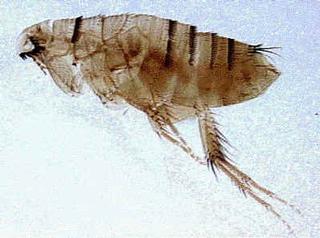

 |
 |
Order
- SIPHONAPTERA
(Greek, siphon = tube; pteron = wing)
Common Name: fleas
Distribution: Cosmopolitan
Description
All fleas are ectoparasites of birds or mammals with mouthparts that are
modified for piercing and sucking. The body of the flea is laterally
compressed (i.e. flattened from side to side) and enlarged hind legs are
modified for jumping. All fleas are wingless. Compound eyes are absent and
only simple eyes (ocelli) may be present. Antennae are present but they
are extremely short and lie within deep lateral grooves in the head so
that they are not readily visible. Antennal structure is a series of
short, straight segments (filiform). The legs of fleas are modified with
hairs and hooks to grasp the hairs of the host.
Larva
The flea life cycle consists of egg, larva, pupa and adult. The eggs are
laid in the host's environment (e.g. nest, kennel, bedding, etc.). Larvae
(that resemble fly maggots) develop on material shed from the host, such
as skin fragments. A loose cocoon is spun by the mature larva for
pupation. Flea pupae can remain dormant for extended periods of time and
there is some evidence that the emergence of fleas is triggered by
vibrations created by the host as it passes by. This seems to be the
reason for the sudden appearance of numbers of fleas in homes that have
not been occupied for some time.
Members
Fleas.
Food
Adults feed on blood while larvae feed on fragments of skin and other body
debris.
Importance
Fleas are extremely important parasites of animals and humans. Apart from
the irritation caused by bites, fleas are the vectors for a number of
diseases such as murine typhus and plague. Allergic responses to flea
bites are common as fleas inject saliva as an anticoagulant for continuous
blood feeding. |